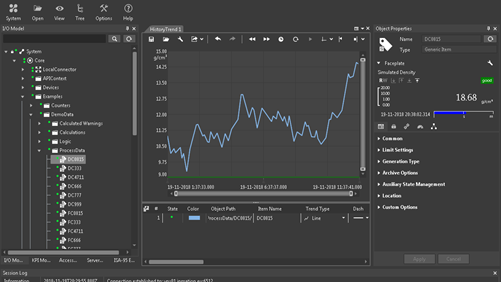DataLyzer
Big Data & SPC integration
SPC and Big Data integration
The DataLyzer PLC/historian interface offers a solution to take aggregate data from OPC clients or historian databases and analyze subgroups in a control chart.
With the interface you can take subgroups at predefined intervals, take averages and dispersion from a predefined interval or convert large amounts of data to attribute subgroups.
In the graph below you see the data imported from the PLC signal in the figure above.

Big data and Industry 4.0
You produce materials and goods that are successful on the global market. Your business is a networked system possibly with several sites and production facilities. Over the past few decades, you have achieved a high degree of automation using the aid of digital technology and have established complex, data-processing systems that support the company’s many processes in an optimal manner.
While the company’s automation has often been divided into the areas of Automation/Control, MES, ERP and Supply Chain, these traditional classifications are increasingly breaking down. The (Industrial) Internet of Things, Big Data, Fast Data and other topics are being touted as the new providers of IT salvation. However, the wise decision is to continue the industrial evolution and use new technical possibilities to further increase the company‘s automation, transparency and efficiency.
The application of new technologies differs according to the industrial sector. For instance, manufacturers of consumer goods increasingly seek to use social networking to connect with their customers, whereas manufacturers of intermediate products strive to achieve more flexible, and consistent process automation with zero-defect manufacturing and real-time networking in the supply chain.
Common to all of these projects is the need for complete, secure and uninterrupted real-time data communication. This needs to overlap, across all production facilities, existing systems, assets and distribution points worldwide. The resultant data cloud has to bring value for each individual decision-maker in your company: at any time, at any place and on any device, while also serving as a general system integration point for any future applications.
Therefore, it is the time to break the classic organizational segments of enterprise IT and create information continuity.
Simultaneously, this closes the gap between OT and IT that was stipulated for decades by leading consultants.
Company automation in the 21st century is a seamless process. The company-wide flow of information in real time can finally unite the technologists within the company to realize considerable added value.
Real time data analysis example
Below you see a historian which takes data from a PLC. Data from tags can be stored with a predefined interval in a Mongo database and data can be retrieved for any time period.

Big data solutions are extremely powerful because you can analyse in detail what has happened. A mistake often made with big data analysis is that people try to find relations (correlations) between process parameters and product characteristics to find the optimum process settings without first analyzing if the process is in control.
When the process is out of control or not all factors are included it will be very hard to find an optimum process setting. To analyze if a process is in control we need to apply SPC.
However big data is not suitable to apply SPC because the amount of data is so high and we will get too many false alarms. So we will need to aggregate data to apply SPC.
